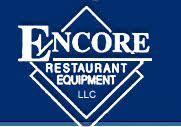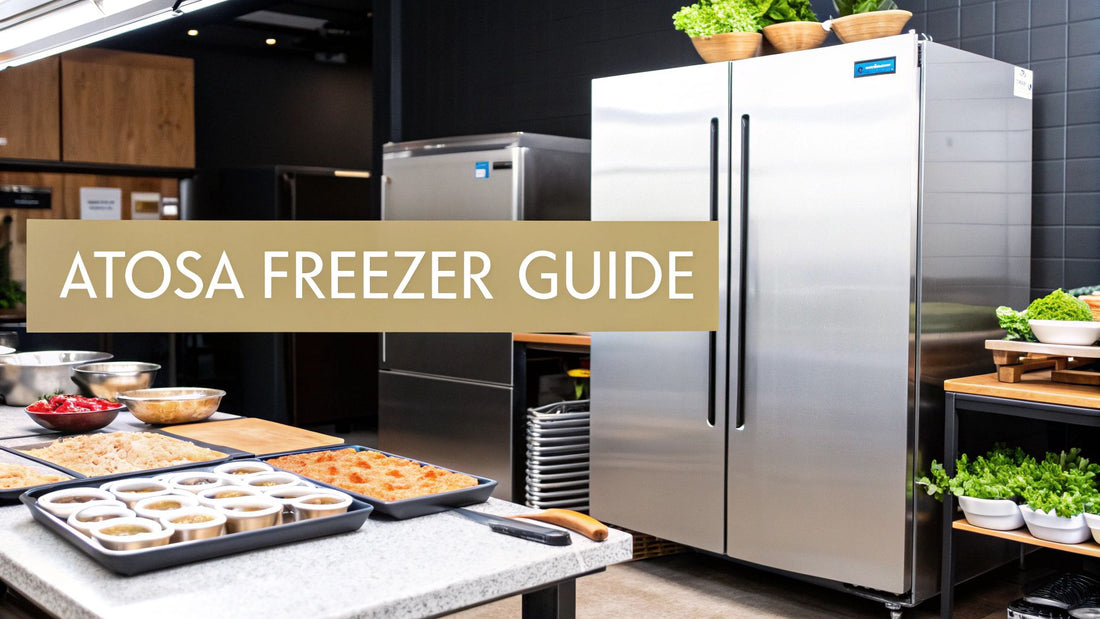
Your Guide to the Atosa 2 Door Freezer
Share
Walk into almost any busy commercial kitchen, and you'll likely spot an Atosa 2-door freezer. There's a good reason for that. This isn't just another piece of equipment; for many chefs and restaurant owners, it’s a trusted workhorse. They count on its tough stainless steel body, its huge storage space, and its unwavering performance to keep things running smoothly.
In a high-stakes kitchen environment, this freezer is more than just a cold box—it's a critical tool for keeping food safe and the back-of-house efficient. Its entire design is geared toward handling the chaos of a busy service, day in and day out. As your partner in equipping a successful kitchen, we're here to provide insights on industry-leading equipment like this, helping you stay ahead of the curve.
Why Top Kitchens Rely on the Atosa 2 Door Freezer
Picking the right freezer is a make-or-break decision for any restaurant. In the heat of service, your equipment has to do more than just work; it needs to be a dependable part of the team. This is exactly where the Atosa 2-door freezer shines, cementing its place as an essential piece of the puzzle for both efficiency and food safety.
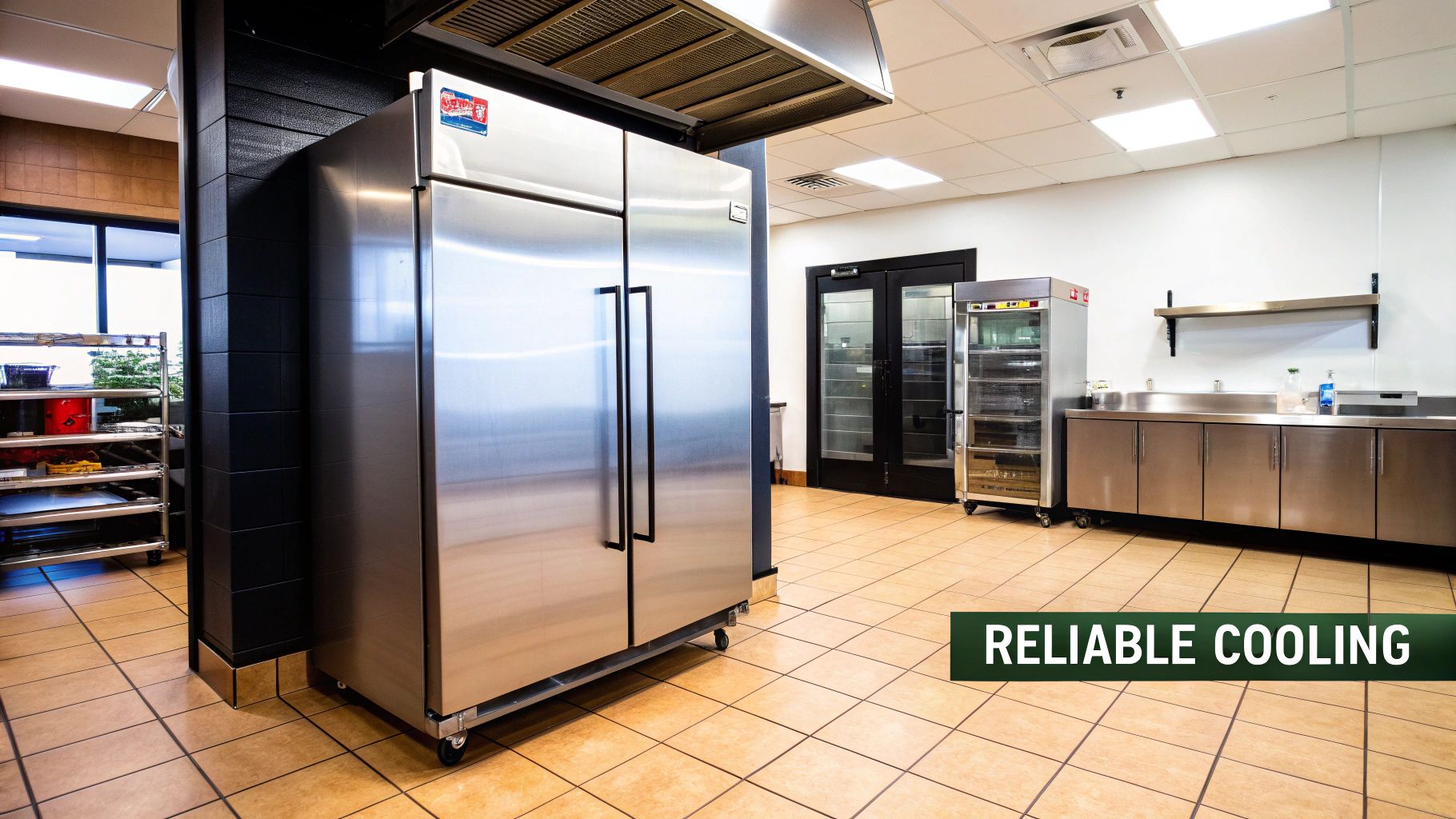
Seasoned chefs don't see this unit as a simple purchase. They see it as an investment in consistency. Its solid construction, generous capacity, and smart design features have a direct, positive impact on the kitchen's rhythm, helping to slash food waste and protect your bottom line. Following industry trends and choosing proven equipment is key to long-term success.
The Foundation of Kitchen Reliability
The Atosa 2 Door Freezer stands out in a global commercial freezer market valued at around USD 1.2 billion, which is expected to climb to about USD 1.8 billion by 2033. This steady growth, at a compound annual rate of roughly 5.1%, is driven by one thing: kitchens demanding refrigeration that's both energy-efficient and built to last. Understanding these trends helps you make smarter purchasing decisions.
Atosa's commitment to stainless steel construction is a big reason it's become a go-to for operators who need equipment they can count on. It's all about stability.
"A reliable freezer is the backbone of food safety and inventory management. An appliance like the Atosa 2 door freezer provides the consistency needed to protect thousands of dollars in product, making it an indispensable asset."
A freezer that holds its temperature without fail is your first line of defense in preserving ingredient quality and maximizing shelf life. That kind of dependability is non-negotiable for controlling food costs and ensuring every dish you serve is up to standard. You can learn more about why the Atosa freezer is a trusted choice in our detailed guide.
Atosa 2 Door Freezer Core Advantages at a Glance
So, what exactly makes this freezer such a smart addition to your kitchen? This table breaks down the key benefits and shows how they directly translate into real-world advantages for your restaurant.
| Benefit | Impact on Your Restaurant |
|---|---|
| Durable Stainless Steel Construction | Resists the dents, dings, and corrosion of a fast-paced kitchen, guaranteeing a long life and simple cleanup. |
| Generous Storage Capacity | Offers plenty of space for bulk purchases, leading to better organization and fewer last-minute trips to the supplier. |
| Efficient Cooling System | Keeps temperatures rock-steady and safe, protecting your food's quality while cutting down on spoilage and waste. |
| Smart, User-Friendly Design | Practical touches like self-closing doors and adjustable shelves make life easier for your staff and streamline the daily workflow. |
Simply put, these features aren't just specs on a sheet—they're thoughtful solutions designed to address the everyday challenges of running a commercial kitchen.
Decoding the Specs for Real-World Kitchen Performance
A spec sheet can feel like reading a foreign language. All those numbers and technical terms don't always paint a clear picture of how a piece of equipment will actually hold up in a busy kitchen. Let's break down what the specifications on an Atosa 2-door freezer really mean for your day-to-day operations, the quality of your food, and your bottom line.
Think of your freezer as the high-security vault for your most valuable inventory. Its performance specs are the combination that keeps everything inside safe and sound. We’ll go beyond the numbers to show you how each feature—from its capacity to the type of compressor it uses—is designed to perform under the intense pressure of a commercial kitchen. Knowing these details helps you make a much smarter investment.
Translating Capacity into a Smoother Workflow
When we talk about a freezer's capacity in cubic feet, we're really talking about your kitchen's organization and efficiency. A freezer that's too small inevitably leads to over-stuffing. When that happens, you block airflow, which creates hot and cold spots and puts your food at risk. An Atosa 2-door freezer gives you a generous amount of space, letting you take advantage of bulk purchasing without turning your freezer into a chaotic, unorganized mess.
This kind of practical storage is a huge reason the reach-in freezer market is booming—a category currently valued at around USD 23.42 billion. It's on track to hit USD 33.97 billion by 2030, driven by restaurants and foodservice businesses that need that perfect mix of ample storage and quick access. The two-door design is particularly popular, with capacities often falling between 15 to 30 cubic feet, hitting the sweet spot for many kitchens. You can find more market data by checking out the reach-in freezer market analysis on GII Research.
This image gives you a great visual of how key Atosa specs like storage space, energy use, and temperature range stack up against the market average.
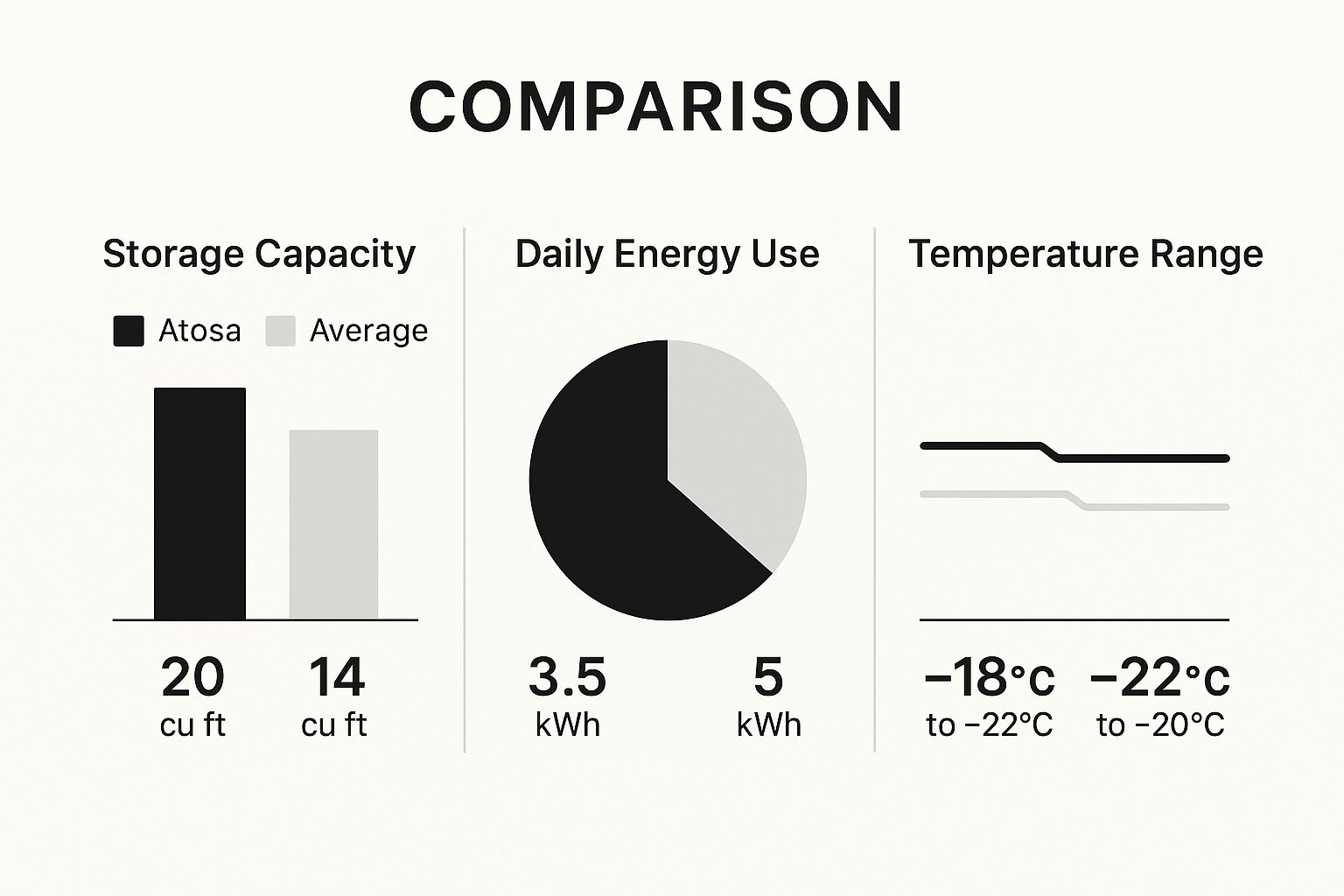
As you can see, an Atosa unit doesn't just give you more room; it also runs more efficiently while holding colder, safer temperatures.
The Compressor: The Unsung Hero of Cold Storage
If the freezer is the vault, the compressor is its engine, working around the clock to maintain that perfect, frozen environment. Where that compressor is placed and what kind it is matters a whole lot. Atosa models often come with bottom-mounted compressors, which is a huge practical advantage in a hot kitchen.
Think about it: a bottom-mounted compressor pulls in cooler air from down near the floor. It doesn't have to work nearly as hard as a top-mounted unit, which is stuck sucking in all the hot, greasy air rising from your cookline. This means lower energy bills and, just as importantly, much easier access for cleaning the coils.
It’s a smart design choice that makes a real difference in your utility costs and the lifespan of the freezer itself. It's a small detail with a big operational impact. You can get a deeper dive into these features in our complete Atosa freezer 2 door review.
Comparing Popular Atosa 2-Door Freezer Models
Not all Atosa 2-door freezers are created equal. Depending on your kitchen's layout and storage demands, one model might be a better fit than another. To help you discover the best fit, here’s a quick comparison of the latest models to see the key differences at a glance.
| Model Number | Cubic Feet | Dimensions (W x D x H) | Compressor Type |
|---|---|---|---|
| MBF8005GR | 49.1 | 54.4" x 31.7" x 83.1" | Bottom-Mounted |
| MBF8507GR | 46.8 | 54" x 31" x 82.8" | Top-Mounted |
| MBF8002 | 49 | 54.4" x 31.7" x 81.3" | Bottom-Mounted |
This table highlights how things like capacity and compressor placement vary between models. Choosing the right one comes down to matching these specs to your specific operational needs—whether that's maximizing every cubic foot of space or prioritizing a compressor type that fits your kitchen's environment.
Why Stainless Steel and Temperature Range Are a Big Deal
The materials and temperature range of your freezer are your first lines of defense against spoilage and other operational headaches.
- Durable Stainless Steel: Atosa uses high-grade stainless steel for the interior and exterior, and that’s not just for looks. It stands up to the dents, dings, and corrosion that are just a part of life in a busy kitchen, making it far easier to keep clean and sanitary.
- Precise Temperature Control: These freezers typically operate between -8°F and 0°F (that’s -22°C to -18°C). This isn't just "cold"—it's a very specific and stable temperature range. That deep, consistent freeze is what preserves the texture, flavor, and, most importantly, the safety of your food for the long haul.
These features work in tandem to give you a reliable workhorse that protects your inventory and keeps your kitchen running smoothly.
How Smart Design Lowers Your Energy Bills
In any restaurant, your utility bill is one of those relentless, nagging overheads. Every single dollar you can knock off that monthly expense is pure profit. The Atosa 2-door freezer was clearly built by people who get this, packing in smart design choices that slash electricity use without sacrificing an ounce of performance. It’s not just about freezing food; it’s about doing it as leanly as possible.
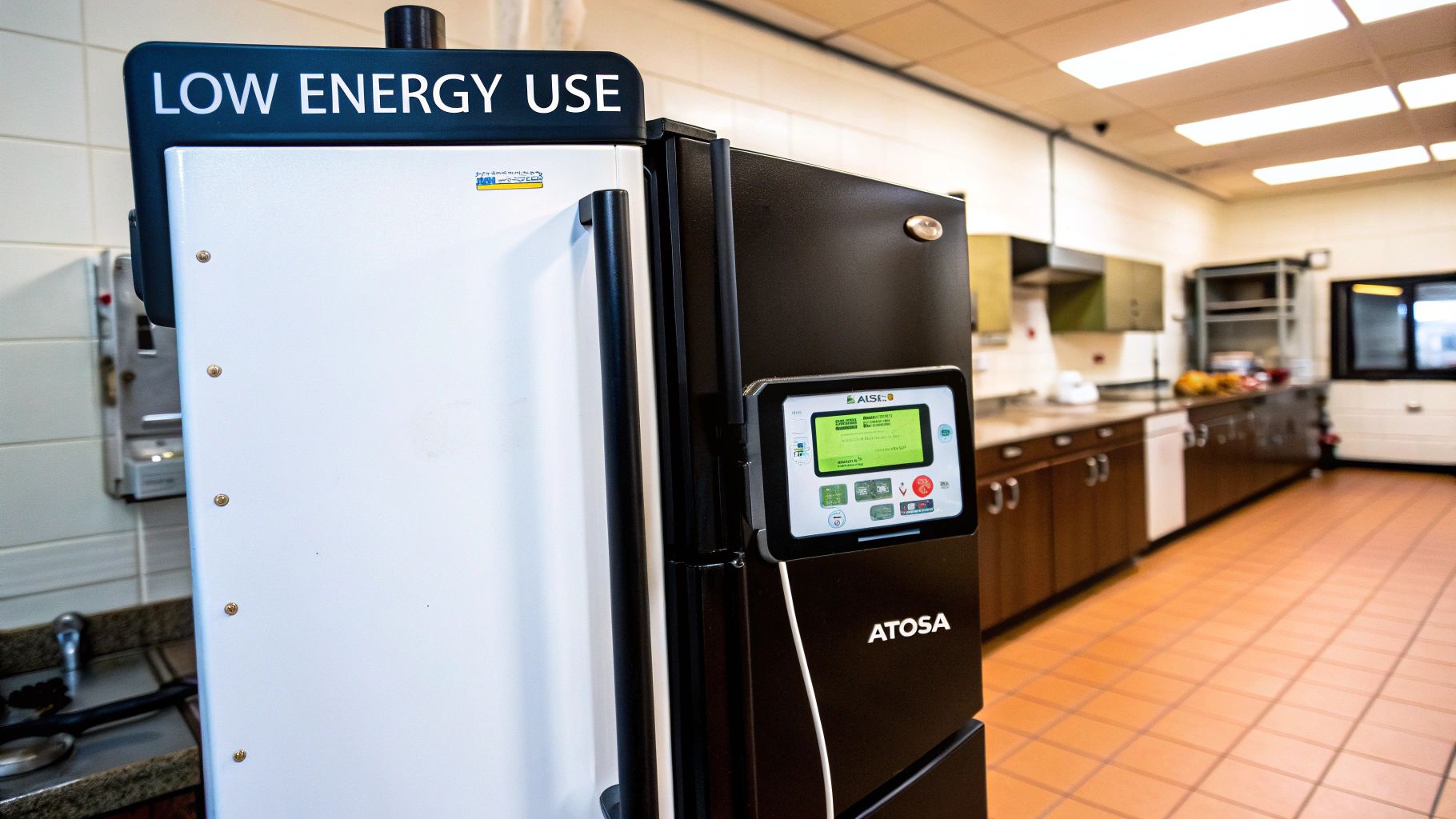
Think about it this way: an inefficient freezer is like a boat with a slow, constant leak. The motor—the compressor—has to run nonstop just to bail out the "warm air" that’s always seeping in. That’s a huge waste of energy and it wears out the motor. Atosa’s design is all about plugging those leaks so the cooling system can work smarter, not harder.
The Power of Eco-Friendly Refrigerant
The real heart of this freezer’s efficiency is its R290 refrigerant. This isn't just some random chemical; it's a modern, eco-friendly hydrocarbon that has quickly become the gold standard for high-performance commercial refrigeration. Keeping an eye on refrigerant trends like this is key for chefs and owners planning for the future. And while it’s great that it has a near-zero impact on the ozone layer, the real win for your wallet is its thermodynamic efficiency.
What does that mean in plain English? It absorbs and gets rid of heat more effectively than older refrigerants. This allows the compressor to chill the cabinet down to temperature much faster and then shut off. Shorter run times directly mean lower electricity bills and less strain on the single most important part of your freezer.
High-Density Insulation That Locks in Cold
Of course, a powerful cooling system is only half the equation. If your freezer can’t hold onto that cold air, you're just throwing money away. This is where Atosa’s high-density, CFC-free polyurethane insulation really shines.
It’s like trying to keep your coffee hot in a paper cup versus a Yeti tumbler. The tumbler's thick, insulated walls stop heat from escaping. Atosa’s insulation does the exact same thing, but in reverse—it creates a powerful barrier that keeps the ambient heat of a busy kitchen from getting in.
This top-notch insulation dramatically cuts down on passive heat gain. The compressor simply doesn't have to kick on as often to maintain that rock-solid freezing temperature. It's this one-two punch of efficient R290 refrigerant and thick insulation that's the real secret to the freezer's low energy footprint.
- R290 Refrigerant: Cools the interior fast and efficiently.
- High-Density Insulation: Keeps the cold in and the heat out.
- Self-Closing Doors: A simple but brilliant feature that minimizes how long the interior is exposed to warm air during a busy service.
Put it all together, and you can see why so many Atosa models boast the ENERGY STAR certification. That's not just a fancy sticker; it's a third-party guarantee from the U.S. Environmental Protection Agency that the appliance meets incredibly strict energy performance standards. An ENERGY STAR certified freezer can be up to 40% more efficient than a standard unit, which translates into serious, tangible savings on your utility bills, month after month.
Getting Your Atosa Freezer Set Up Right
So, your new Atosa 2-door freezer has arrived. Getting it out of the box is the easy part. Where you put it and how you install it are what really lay the groundwork for years of reliable, efficient performance. I've seen it a hundred times: a great piece of equipment that fails early because it was set up in a bad spot. A little forethought now will save you a world of hurt later.
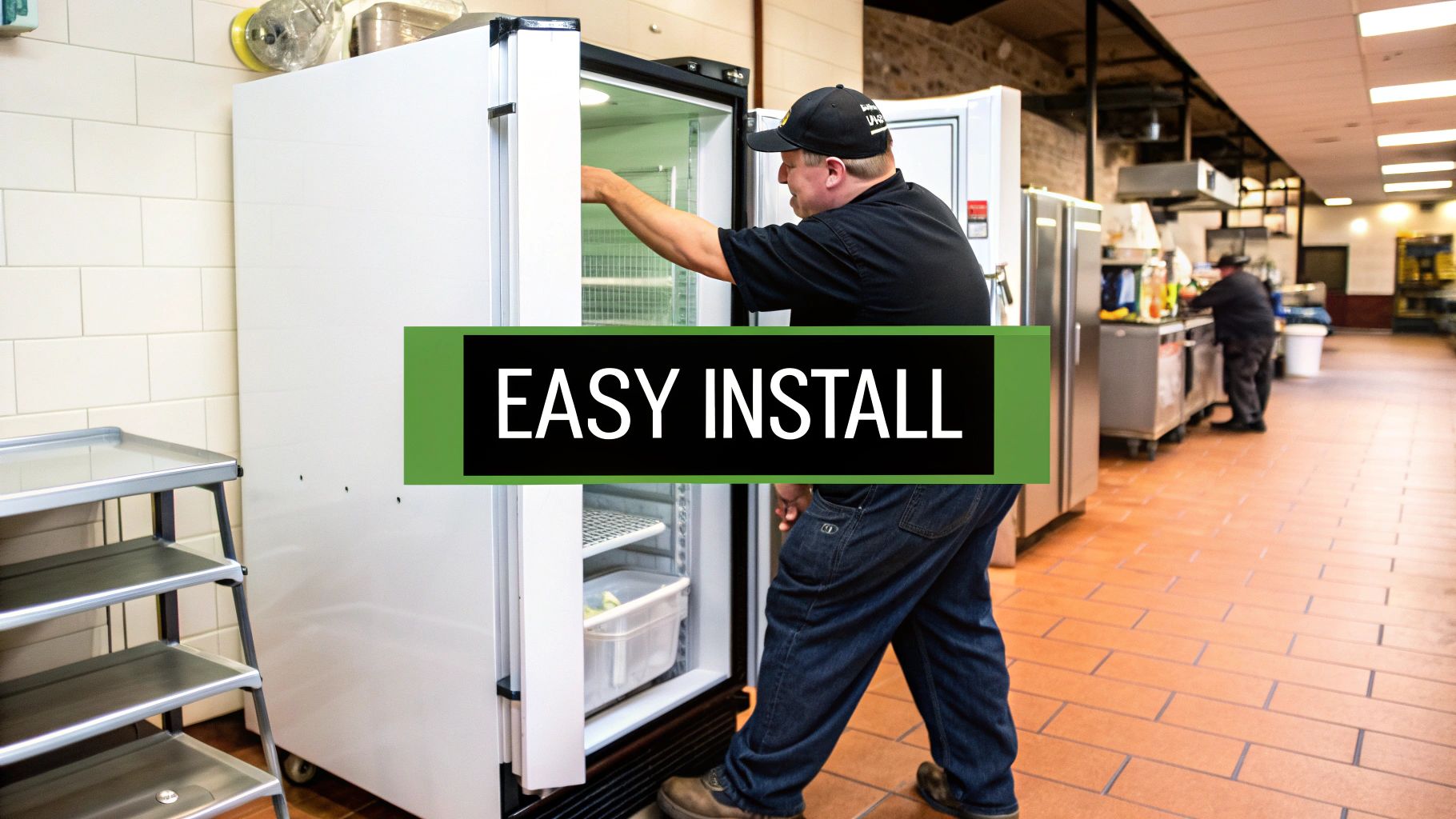
Taking a few minutes to get this right from day one can genuinely prevent overworked compressors, shocking energy bills, and the kind of equipment failures that always seem to happen on a busy Friday night.
Finding the Right Home for Your Freezer
The number one rule? Ventilation. Your freezer isn't just a cold box; it's a heat-moving machine. The compressor and coils are constantly working to pull warmth out of the interior, and they dump that heat out into your kitchen. To do this efficiently, they need a steady stream of cool, fresh air.
Shoving your freezer into a tight alcove or right up against a wall is the fastest way to kill it. Think of it like making a marathon runner wear a heavy winter coat—they're going to overheat and give up. You need to leave at least 4-6 inches of clear space around the back and sides. It’s also a rookie mistake to place it right next to your oven, fryer, or any part of the hot line.
The further away you can get from the cookline, the better. Every bit of extra heat in the air forces the compressor to work that much harder, which directly translates to a shorter lifespan and higher electricity costs.
Give your Atosa freezer the breathing room it needs, and you're already halfway to ensuring it has a long, productive life in your kitchen.
Your Step-by-Step Installation Checklist
Once you've picked out the perfect spot, don't just plug it in and walk away. Running through a quick checklist ensures everything is stable, safe, and ready for your valuable inventory.
-
Get it Level: Your freezer needs to sit on a solid, level floor. If it's tilted, the doors won't seal properly. That means air leaks, which lead to frost, which leads to your freezer working overtime. Use the adjustable feet to get it perfectly stable.
-
Power It Properly: This is a big one. Your freezer needs its own dedicated electrical circuit. Do not, under any circumstances, use an extension cord or plug it into a power strip with other appliances. It's a major fire risk and can starve the compressor of the consistent voltage it needs to run properly.
-
Wipe It Down: Before you start loading it with product, give the inside a good cleaning with some warm water and a mild, food-safe detergent. This gets rid of any dust or residues from the factory and shipping process.
-
Let it Chill Out: After you plug it in, leave it running empty for at least 24 hours. This gives the system time to pull down to its target temperature and stabilize. Dropping a full load of room-temperature food into it right away puts a massive strain on the system. Patience here pays off.
Simple Maintenance to Extend Your Freezer's Lifespan
https://www.youtube.com/embed/o4kAIYtxVgs
You've invested in a workhorse with your Atosa 2-door freezer, and protecting that investment is easier than you might think. Just like your car needs a regular oil change to keep the engine from seizing up, your freezer needs a bit of consistent attention to perform at its best for the long haul.
Skipping basic upkeep is a fast track to headaches you don't need—skyrocketing energy bills, spoiled inventory, and the dreaded emergency call to a repair tech on a busy Friday night. The good news is that a little proactive care goes a long, long way. By setting up a simple routine, you can keep your unit running efficiently and reliably, protecting the thousands of dollars of product inside.
Your Essential Maintenance Schedule
The best way to think about freezer care is to break it down into simple intervals: daily, weekly, and monthly. None of these tasks take much time, but they are absolutely critical to the health of your machine. A dependable freezer is a cornerstone of any food business, which helps explain why the global commercial refrigeration market is booming. The Asia Pacific region leads the pack, holding roughly 37% of the market with revenues topping USD 31.6 billion, as businesses continue to invest in reliable equipment. You can see more on these refrigeration market trends from Cognitive Market Research.
Daily Checks (Less than 5 minutes):
- Wipe Down Door Seals: Give the door gaskets a quick wipe with a damp cloth. This clears away crumbs and spills that can prevent a tight seal, which is a major cause of energy-wasting air leaks and frost.
- Check Temperature Display: A quick glance at the digital controller is all it takes. Just confirm it’s holding steady in the target range, which is usually -8°F to 0°F.
Weekly Tasks (About 10-15 minutes):
- Deep Clean Door Gaskets: Use warm, soapy water to really get into the folds of the gaskets. A clean, tight seal is your number one defense against an overworked compressor.
- Inspect for Frost: Take a look inside the cabinet. A very light dusting of frost is normal, but if you're seeing thick sheets of ice, it's a red flag that you have an issue with the door seal or the defrost cycle.
Monthly Tasks (About 20-30 minutes):
- Clean the Condenser Coils: If you do only one thing on this list, make it this one. It's the most important maintenance task, period. Unplug the freezer, then use a stiff brush and a vacuum to clear all the dust, grease, and grime off the condenser coils. Clean coils let the system breathe, preventing the compressor from overheating and failing years before it should.
A dirty condenser coil forces the compressor to work up to 30% harder to maintain temperature. Regular cleaning isn't just maintenance—it's a direct cost-saving measure that extends the life of your freezer's most vital component.
Simple Troubleshooting for Common Issues
Even a perfectly maintained freezer can have an off day. Before you call for service, here are a couple of common issues you can often solve yourself.
- Problem: Temperature is Too High. First, the obvious: check that the door was shut completely. If that’s not it, take a look at the condenser coil. If it’s caked in dust, that’s almost certainly your culprit. A good cleaning often gets things back to normal.
- Problem: Excessive Frost Buildup. This is almost always caused by one of two things: a bad door seal or staff leaving the door open for too long. Inspect the gasket for any cracks or tears and make sure it’s making solid contact all the way around the frame.
Following these simple steps will empower you to handle the small stuff in-house. For a broader look at equipping your kitchen, our guide on building a commercial kitchen equipment checklist is a great resource. Of course, if a problem persists after you’ve tried these fixes, it’s time to call in a qualified technician.
Got Questions? We've Got Answers
When you're looking at a major piece of equipment like an Atosa 2-door freezer, a few questions are bound to pop up. For busy restaurant owners and chefs, getting straight answers is the only way to make a smart buy. We've put together the most common practical questions we hear, so you can feel confident about your choice and know how to get the most out of it from day one.
Let's dive into the details that really matter in a working kitchen.
What’s the Deal with the Atosa Warranty?
Peace of mind is everything, and Atosa's warranty is pretty solid, showing they stand behind their gear. Typically, you're looking at a two-part warranty. First, there's a two-year parts and labor warranty that covers the nuts and bolts of the unit against defects.
The real standout, though, is the extended five-year warranty they almost always offer on the compressor itself. Think of the compressor as the engine of your freezer—it’s the most important part, so having it covered for that long is a huge plus. Just remember to register your freezer when you get it to activate the warranty, and always double-check the exact terms with your dealer.
How Should I Load Up the Freezer for Best Results?
Organizing your freezer isn't just about keeping things neat; it's absolutely crucial for performance and food safety. The golden rule? Don't cram it full. You need to leave at least 2-3 inches of space between your food and the freezer's inside walls.
That gap is what lets cold air move around, knocking out warm spots and making sure everything stays frozen solid at the right temperature. Good organization also just makes your kitchen run smoother.
It's all about "First-In, First-Out" (FIFO). This simple system ensures you use up older stock first, which cuts down on waste in a big way. Just slide new inventory to the back and pull the older stuff forward. Using clear, labeled bins also helps your team grab what they need fast, keeping that freezer door shut as much as possible.
And a non-negotiable food safety rule: always store raw meats on the bottom shelves. This prevents any drips from contaminating the food below. It's a simple habit that makes a world of difference.
What’s the Best Way to Clean the Stainless Steel?
Keeping that professional shine on your Atosa freezer is easy if you do it right. All you need is a soft microfiber cloth, some warm water, and a little mild soap. The most important trick is to always wipe in the direction of the steel's grain, never against it. This simple step prevents those tiny scratches that can dull the finish over time.
For tougher grime or to really make it pop, a dedicated stainless steel cleaner works wonders. That said, there are a few things you should absolutely avoid:
- Abrasive Stuff: Stay away from steel wool, scratchy scouring pads, or gritty powders. They will permanently scratch and ruin the surface.
- Harsh Chemicals: Chlorine-based cleaners, especially bleach, are a big no-no. They can actually cause stainless steel to corrode and rust.
- Skipping the Rinse: After you clean, always give it a good rinse with clean water and dry it completely with a soft cloth to avoid water spots and ugly streaks.
Can I Just Plug This Thing into an Extension Cord?
Let me make this crystal clear: absolutely not. You should never, ever use an extension cord to power a commercial freezer. These are heavy-duty machines that pull a lot of power to keep their compressors running.
An extension cord just isn't built for that kind of constant electrical load. It can easily overheat and become a serious fire hazard in your kitchen. On top of the safety risk, an extension cord can cause a voltage drop, which essentially starves the compressor for power. This leads to poor cooling, can burn out the motor, and will definitely void your warranty.
Your Atosa 2-door freezer needs to be plugged directly into a dedicated wall outlet that's rated for its specific voltage and amperage. No exceptions.
Ready to invest in a freezer that works as hard as you do? At Encore Seattle Restaurant Equipment, we offer the best prices on the Atosa 2-door freezer, backed by expert advice and real-world experience. For exclusive deals and the latest news on essential restaurant supplies, you're in the right place. Explore our full range of Atosa commercial refrigeration and find the perfect fit for your business today.
